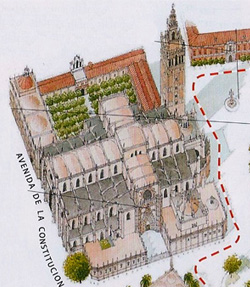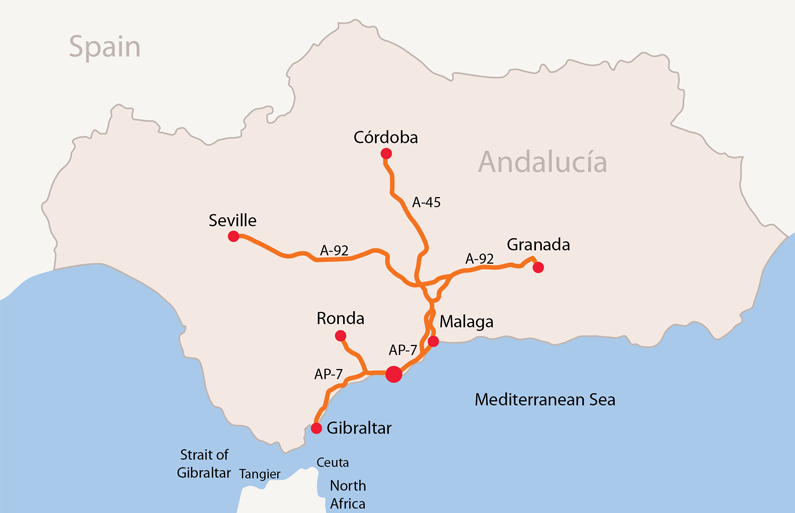
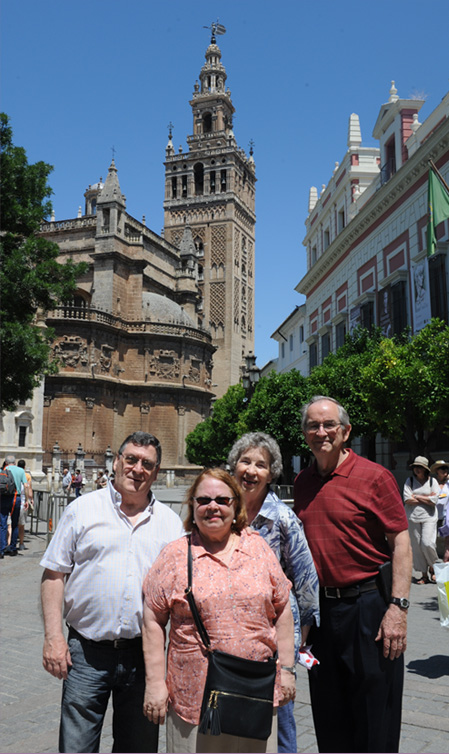 | Visiting SevilleMay 30, 2017This photo is a great symbol for a wonderful visit to which I had long looked forward!Manuel Olmo in Seville has been my ally and translator since 2011 in the development of the Spanish edition of HyperPhysics. He has accomplished far more than the combined effort of the other translators who promised to translate into a dozen languages. He finished the translation of the text portion of HyperPhysics in about four years, which would be equivalent to about 6000 pages if placed in paper print. Since then he has been helping me translate the illustrations, which number several thousand. As I can upgrade the graphics, I send them to him by email. He translates and emails them back to me. One of my main hopes on this trip to Spain was to find some way to honor Manuel for his excellent work. Our visit to Seville allowed Brenda and I to meet and have a time of fellowship with Manuel and his wife Alicia. It was a time of great joy for which we praise the Lord. Manuel invited us to his home, and after a time of fellowship there, they guided us on a walking tour of the area of Seville named Santa Cruz, which is the Jewish Quarter from historic times. It is a beautiful and very interesting area which includes the tower called the Giralda which is in the background of the picture at left. We had lunch in one of the small restaurants for which the Jewish Quarter is famous, and that allowed us to extend our time of conversation. |
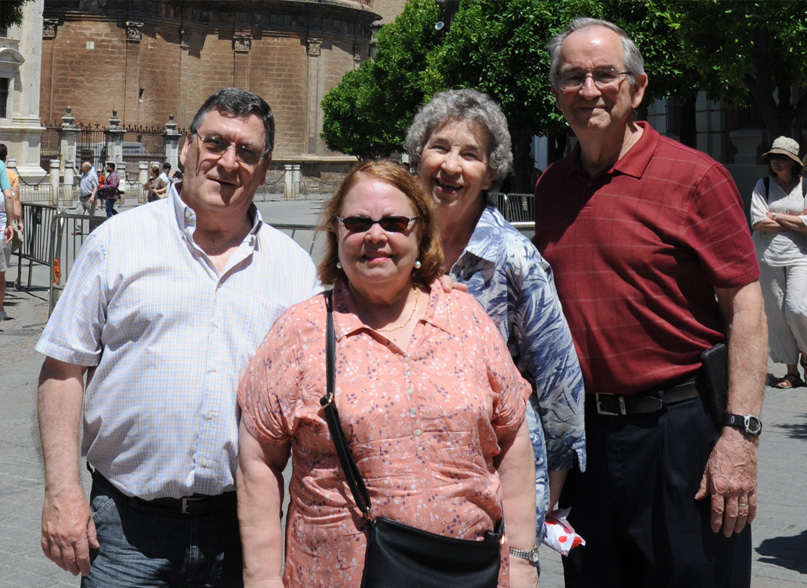
When we arrived at Manuel's address after the drive from the coast, he had made arrangements for us to park under the shelter and had opened the gate for us. We then went over to the second block, and pressed the button for his address to open the door, and went up the elevator to the 5th floor.
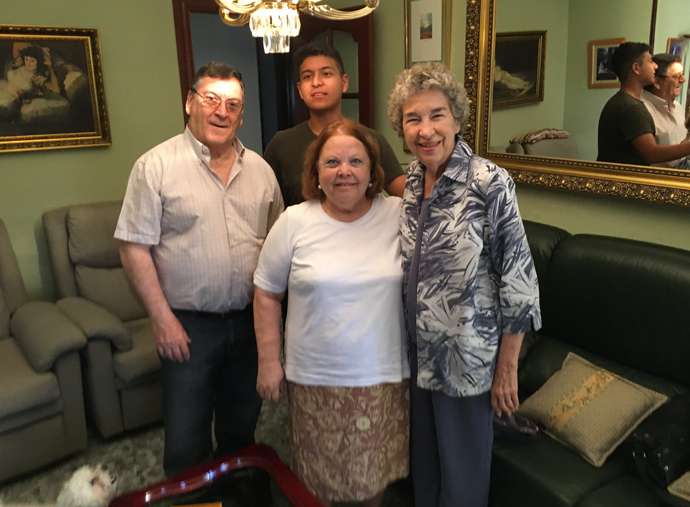 | It was a great privilege to be invited up to their lovely home. |
Manuel and Alicia Olmo, Brenda and Rod Nave. Manuel and I had worked together through a lot of physics material, and it was great to meet him in person. I was very pleased for Brenda and Alicia to meet. |  |
Manuel showed Chris and I around their home while Alicia gave Brenda a tour. Brenda speaks very little Spanish and Alicia very little English, but it did not surprise me that they had a good time of fellowship together.
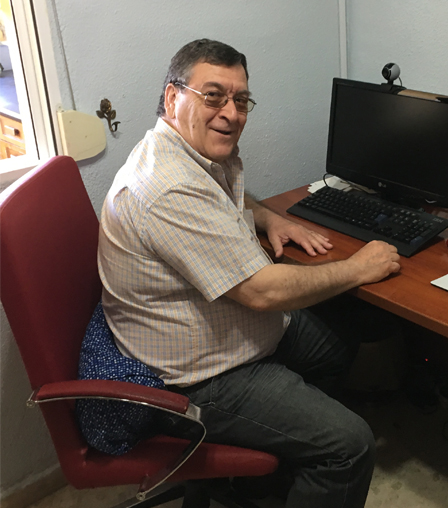 | Manuel's office where he presumably did much of the work on which we have cooperated in HyperPhysics.  |
After visiting in their home, they joined with us in our car and Manuel guided me to drive to downtown Seville into the Santa Cruz area which was the ancient Jewish quarter. We parked the car in an underground parking lot and they led us on a walking tour of part of that area.
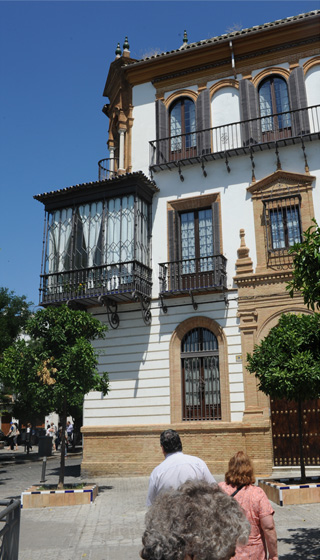 |  |
| They led us by this ornate building which undoubtedly has hundreds of years of history. But I have to admit that I was more impressed by this beautiful orange tree that was growing right there in the center of the city. There was also a touch of amusement at the problems the people might have if they parked their car in the park area where a number of orange trees were growing. The other thing that came to mind was that when I see oranges, I immediately think of Florida. So it was interesting to think that when people in this part of the world see oranges, they think of Seville! Or Cordoba - we saw lots of oranges there as well. | 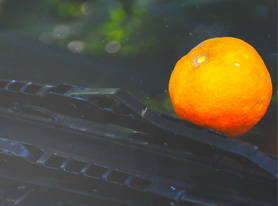 |
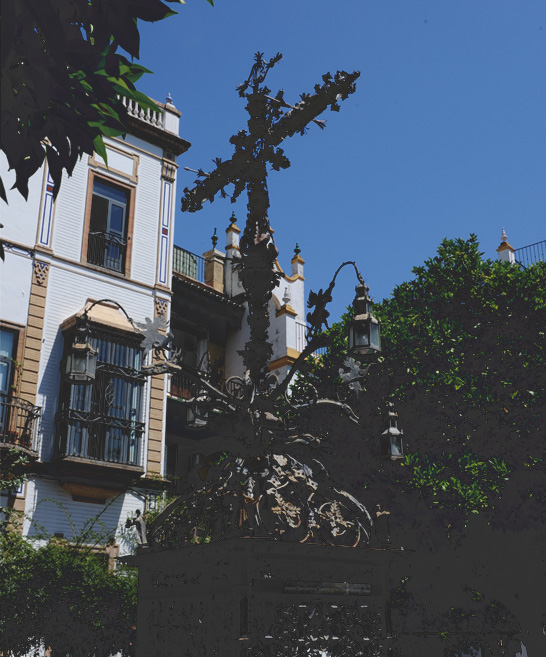 | We walked by this incredibly ornate wrought iron cross which dates to 1692. It is in the center of the Plaza Santa Cruz. It is called the Cruz de la Cerrajeria ("Locksmith's Cross). 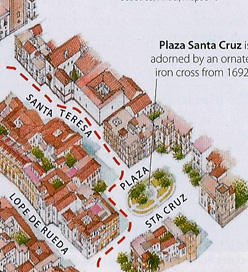 |
From the Plaza Santa Cruz we walked through a narrow street with shops to the Lope de Rueda. 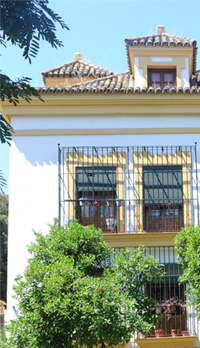 | 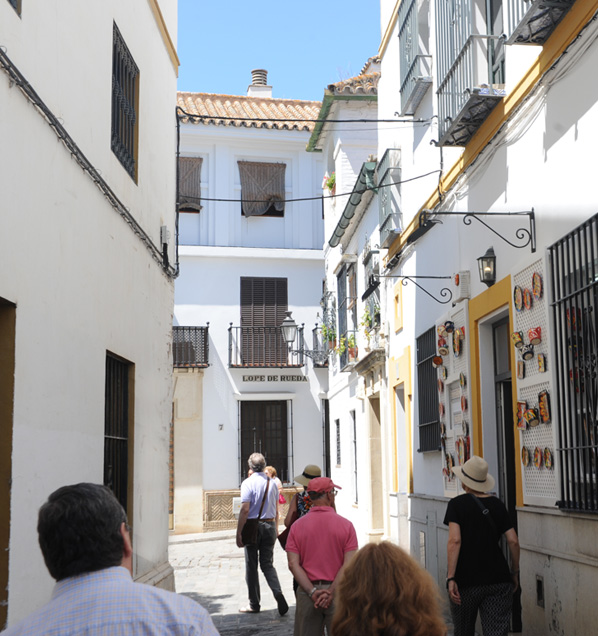 |
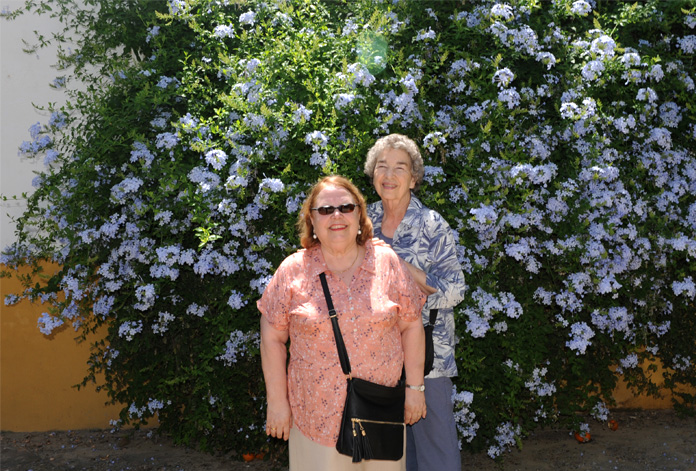 | Alicia and Brenda by one of the beautiful flowering shrubs in the Santa Cruz area. |
We walked beside an ancient wall and through some narrow lanes.  |  |
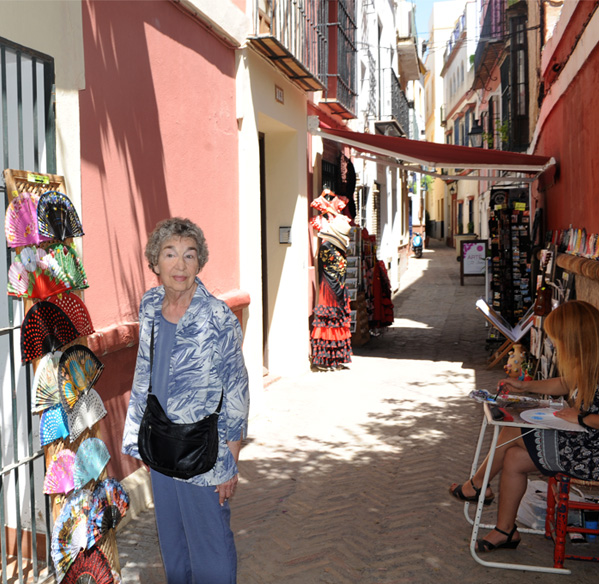 | There were lots of nice craft shops along the narrow lanes. The young lady who was handpainting some fo the fans was working there on the lane. 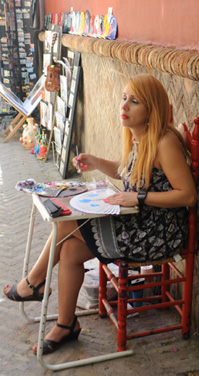 |
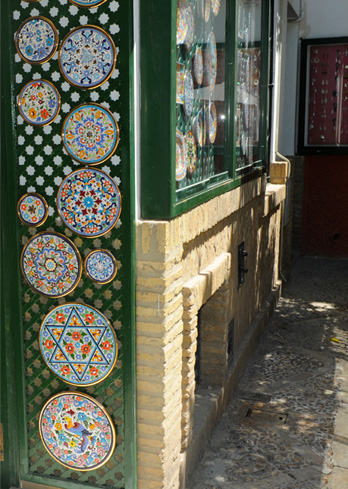 | 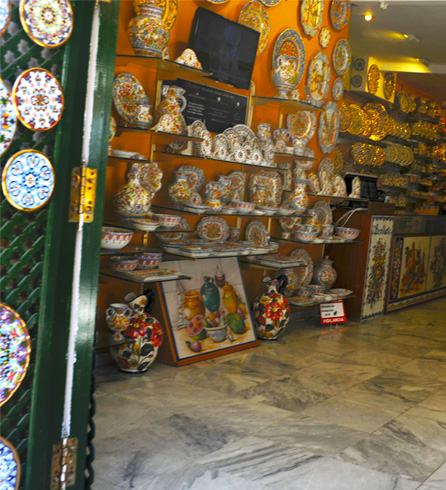 |
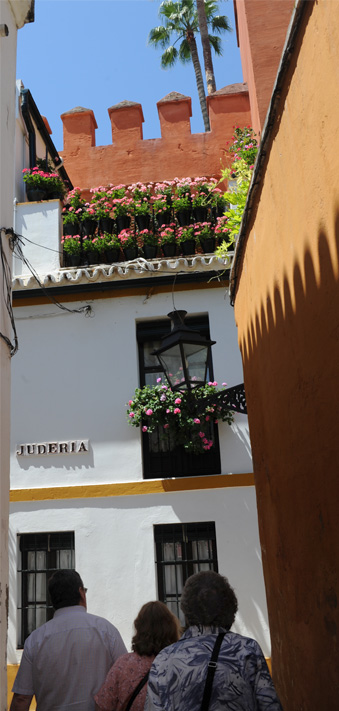 |  |
  | We walked to the marker "Juderia" which we took to indicate a marker of the ancient Jewish Quarter that was here. It is currently called formally the Barrio de Santa Cruz. When we turned the corner, we saw this white building with what looked like a tunnel through it. So we were curious when Manuel and Alicia led us toward that tunnel. 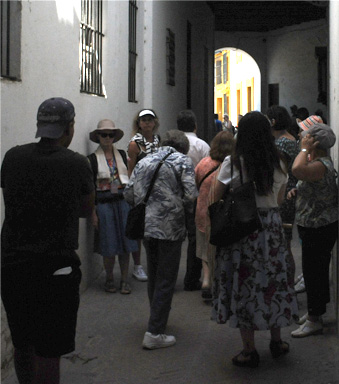 |
But the dark tunnel just heightened our appreciation of what we saw when we emerged from it! La Giralda! Arguably the most famous sight in Seville. That's the advantage of having guides who have known the city for decades. They knew they were bringing us to a dramatic sight. La Giralda was built as a Muslim minaret in 1198. The original Muslim bronze spheres at its top were replaced by Christian symbols by 1400 after the 'reconquista'. In 1568 Hernan Ruiz added a Renaissance belfry which blends with the Moorish base. The name 'La Giralda' is actually taken from the weathervane on top of the structure, which is called "El Giraldilla". |  |


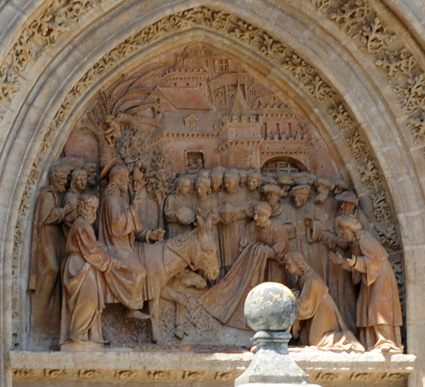 | Chris Suarez, Manuel and Alicia Olmo, Brenda and Rod Nave. We explored the plaza around the Seville Cathedral as crowds gathered for the day's celebration of the Dia San Fernando.
|
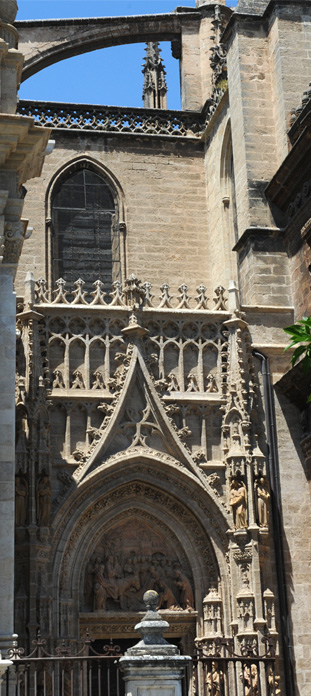 | At left is a view of the door and structure above the sculpture shown above. Below is a closer view of the top of the Giralda where the bell tower was added and the namesake weathervane on the very top. 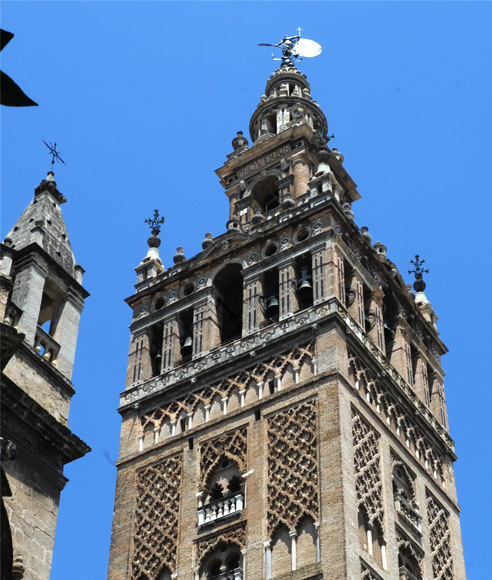 |
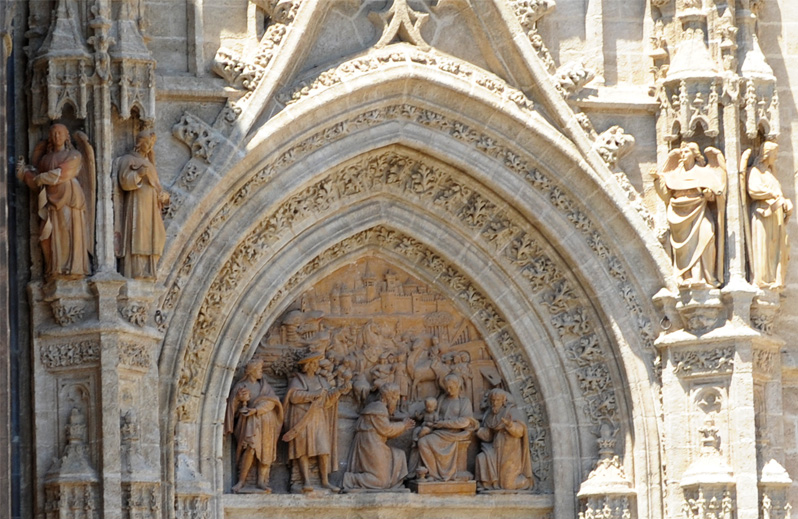
The next door to the Cathedral, shown above, depicted the visit of the Wisemen. It was past this door that we watched the marching band and troops celebrating Dia San Fernando. | 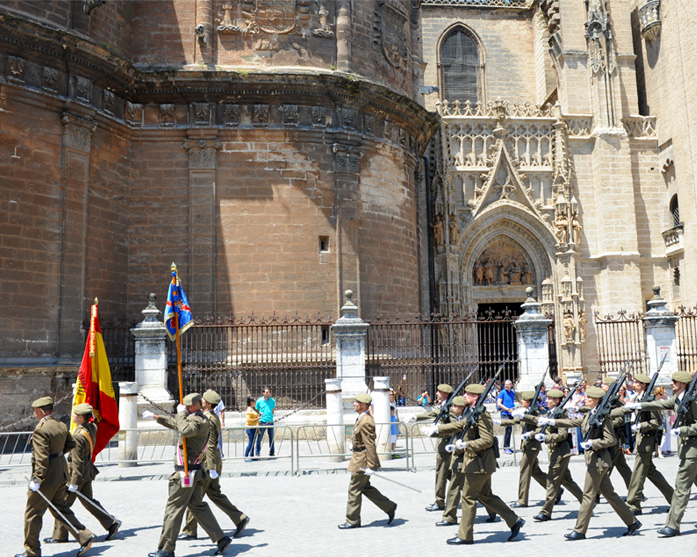 |
 | May 30 is celebrated in Seville as Dia San Fernando. King Fernando II, King of Castile, Galicia and Leon, was the "saviour" of Seville, capturing the city (after Ubeda, Cordoba and Jaen) from the Moors in 1248. San Fernando is buried in Seville Cathedral in the Capilla Virgen de los Reyes (Virgin of the Kings Chapel) where his body is on show on this festive day. A large crowd was gathered for the parade, and I was amused at the forest of cellphones that were raised to take pictures. |
The ancient buildings across the courtyard from the Cathedral were beautifully maintained and decorated. | 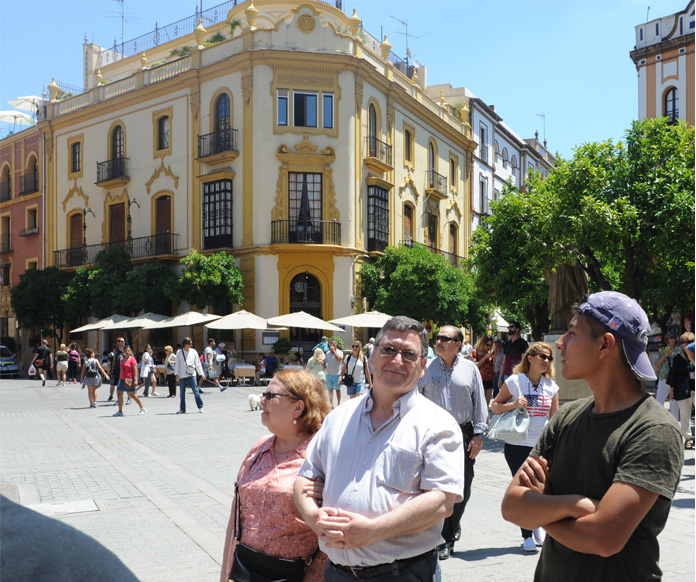 |
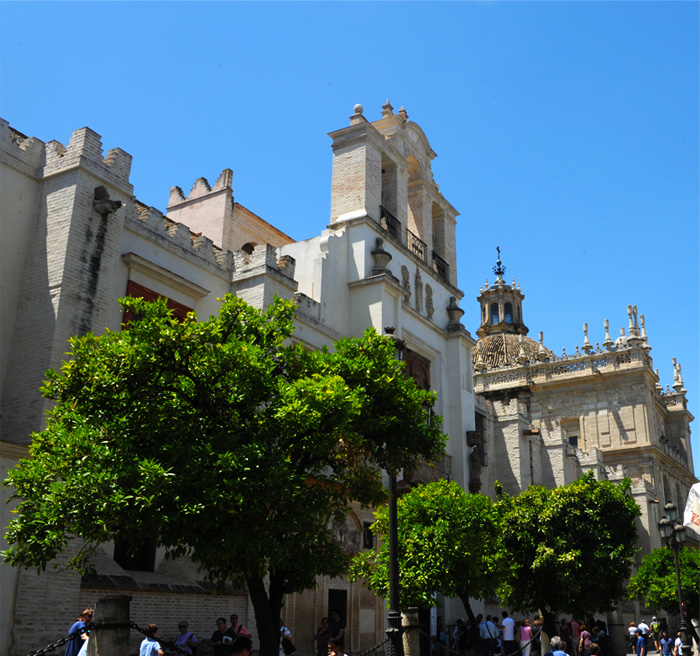 | We walked several blocks through the streets crowded with tourists like ourselves. |
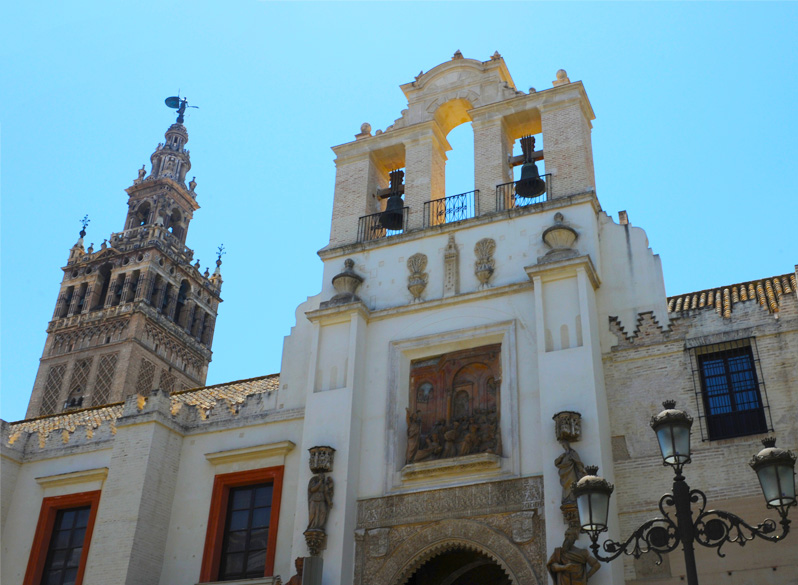

We settled on a restaurant in the area in which to have lunch.
 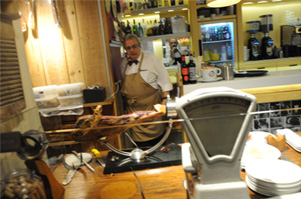 | 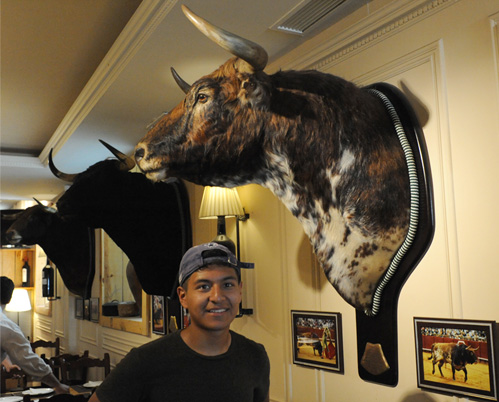 |
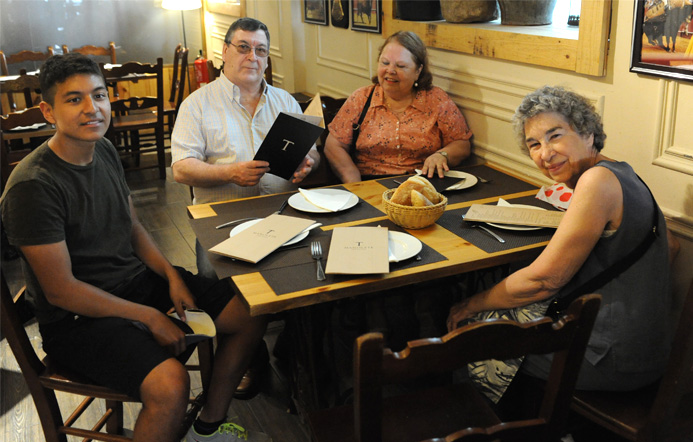 | Chris Suarez, Manuel and Alicia Olmo, Brenda. We settled in for a nice lunch and a great time of fellowship in central Seville. |
Since we had heard so much about the Spanish ham, it was a privilege to watch this fellow expertly carve the thin slices using his specially designed ham rack. | 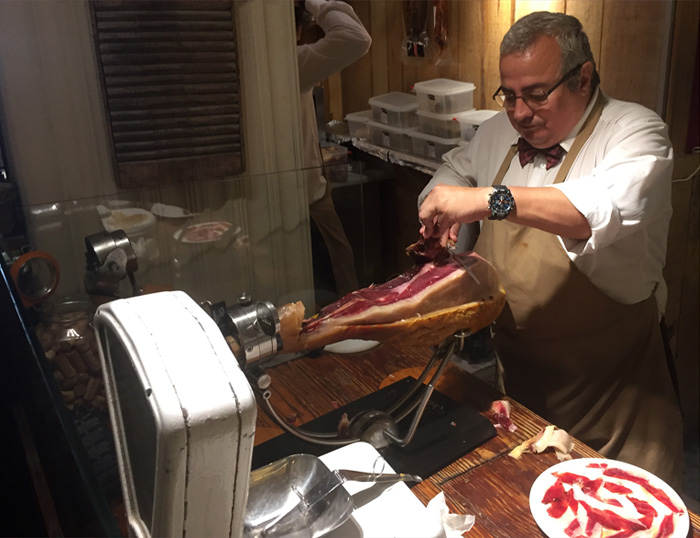 |
 | We shared several dishes, one of which had that famous Spanish thin-sliced ham. |
Another characteristically Spanish dish was a paella with rice and seafood. | 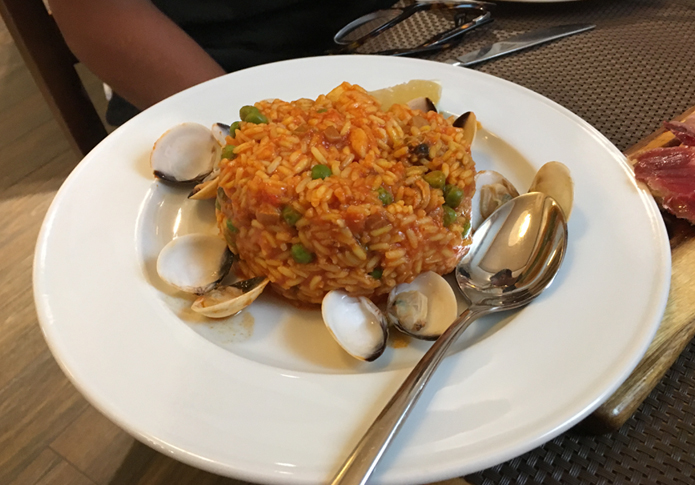 |
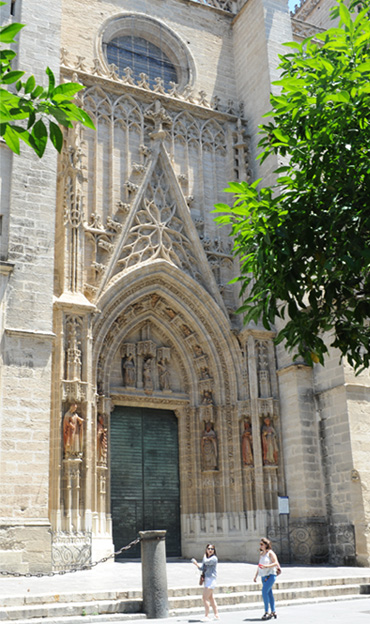 | 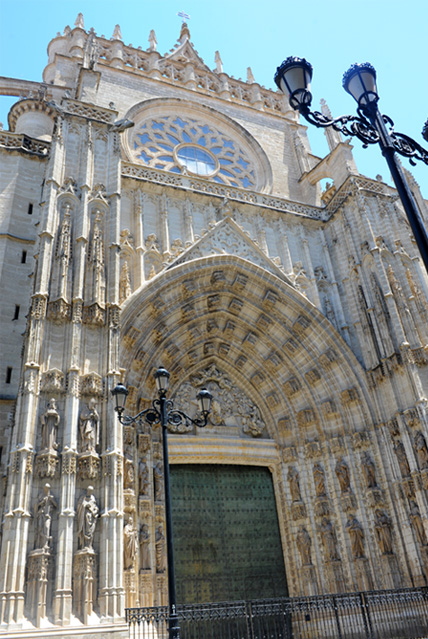 |
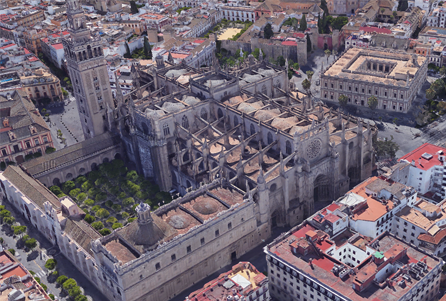 On that side of the Cathedral were tracks on which ran the colorful city trams. Quite a contrast with the architecture of 1400 to 1500 in the cathedral! | 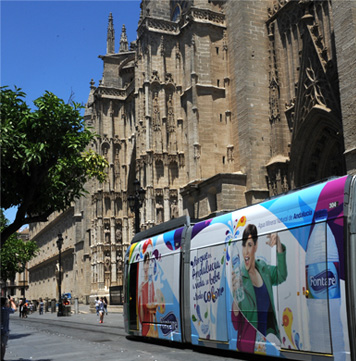 |
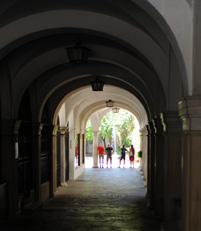 | 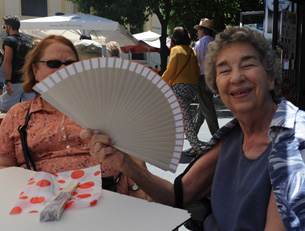 |  |
We had walked through one of the passageways through the buildings to get to the broad street where the trams ran. There we had some ice cream and Brenda made use of one of the fans which were a gift of Manuel and Alicia.
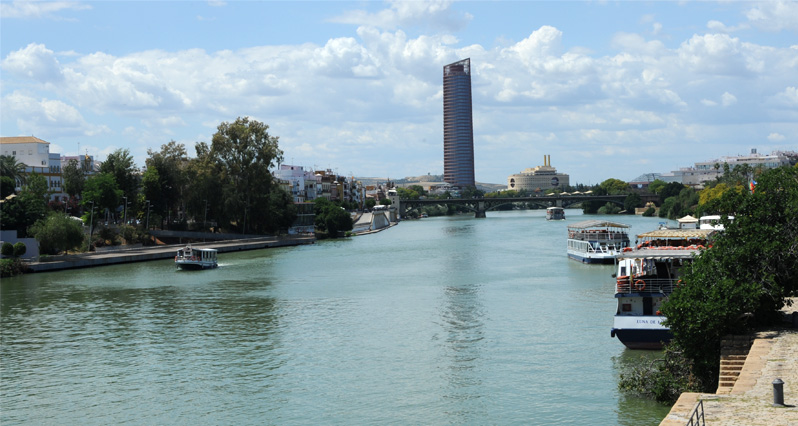
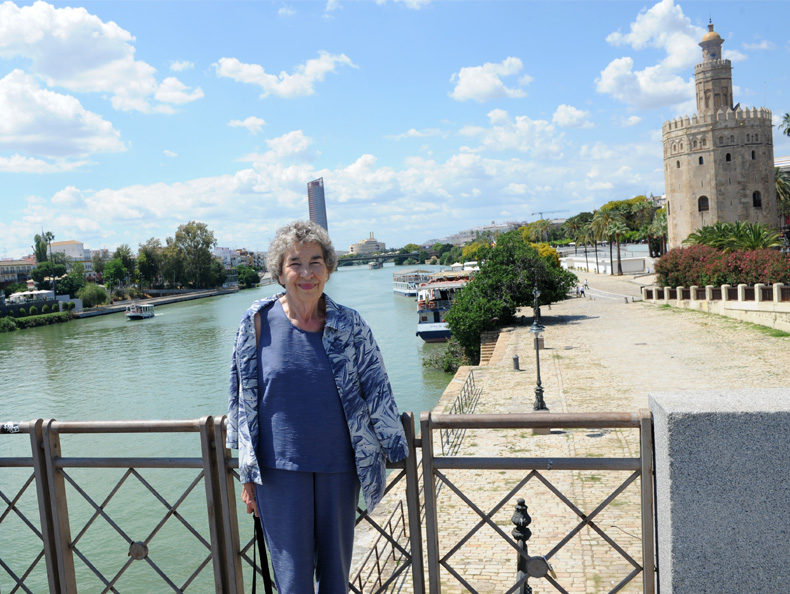
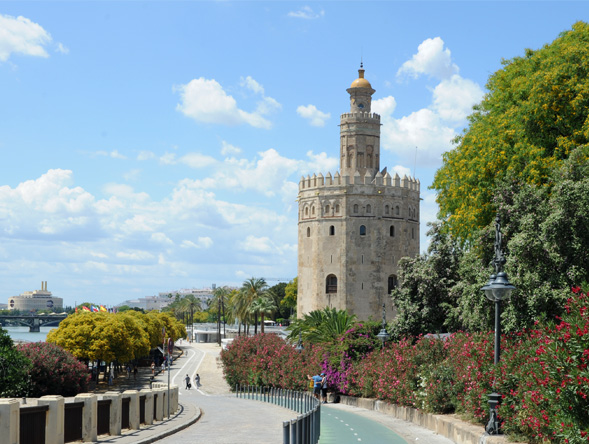 | Brenda with the Guadalquivir River in the background and the Torre del Oro on the right side. "The Torre del Oro or 'Tower of Gold' formed part of the walled defenses of the city, linking up with the Real Alcazar and the rest of the city walls. It was built as a defensive lookout in 1220, when Seville was under the rule of the Almohads. It had a companion tower on the opposite bank, and a great chain would be stretched between the two towers to prevent ships from sailing upriver. " (Seville & Andalusia, DK) |
Touring by horse and carriage was popular in the area, with motorbikes and scooters zipping along among them. |  |
 | 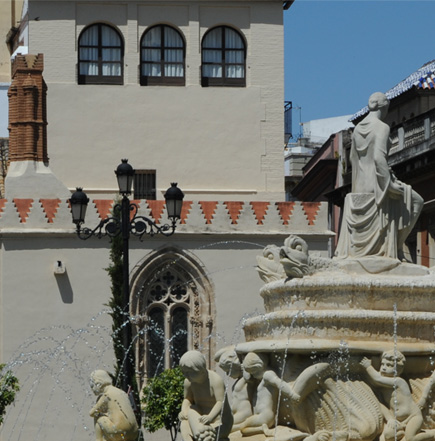 A flamenco dancer entertained a relaxed crowd gathered on this plaza by the fountain. |
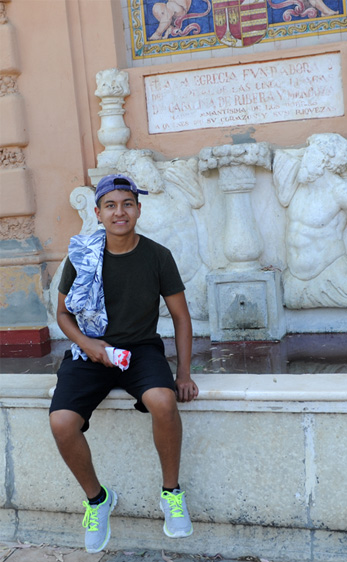 |  |
Upon reaching our car, Manuel guided me back through the city streets to their home and we said goodbye after a very enjoyable and meaningful visit. With Brenda's gps on her phone and Chris watching it for every turn as we wound through the complex roundabouts, we found our way out of the city and back on A-92 for our return trip.
After unloading the car we gathered Chris in a group hug for a prayer of thanksgiving for the day. I had told him that the blessing of this day of meeting Manuel and Alicia and getting to know them had cleared the deck of all the difficulties and frustrations we had the first two days.
| The Road to Ronda |
2017
